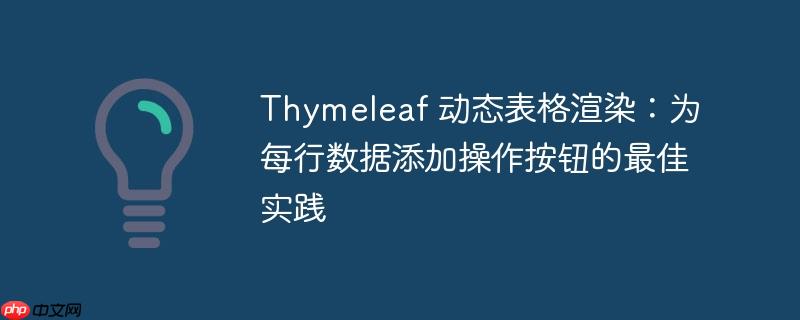
在web应用开发中,我们经常需要展示一个数据列表,并允许用户对列表中的每一项进行操作,例如删除、编辑等。在使用spring boot结合thymeleaf进行前端渲染时,一个常见的问题是如何正确地在表格中循环展示数据,并为每行数据添加一个独立的操作按钮,同时避免按钮被错误地重复渲染。
原始尝试中,开发者试图通过嵌套循环或并行循环来处理描述和ID列表,这导致了操作按钮的重复生成,因为th:each="id : ${idList}"在外部循环的每一迭代中都会再次遍历整个idList,从而创建了多余的按钮。正确的做法是,每行数据应该由一个单一的数据对象来表示,该对象包含该行所需的所有信息(如描述、ID等),然后通过一个主循环来遍历这些数据对象。
解决此问题的关键在于:
首先,我们需要在后端定义一个Java类来封装每行数据所需的所有信息。例如,如果我们希望显示用户的ID和Email,并提供一个删除按钮,可以定义一个User类:
// User.java
public class User {
private Long id;
private String email;
// 可以添加其他需要显示或操作的字段
public User(Long id, String email) {
this.id = id;
this.email = email;
}
// Getters and Setters
public Long getId() {
return id;
}
public void setId(Long id) {
this.id = id;
}
public String getEmail() {
return email;
}
public void setEmail(String email) {
this.email = email;
}
}在Spring Controller中,我们需要创建一个List<User>,并将其添加到Model中,以便Thymeleaf模板可以访问。
// UserController.java
import org.springframework.stereotype.Controller;
import org.springframework.ui.Model;
import org.springframework.web.bind.annotation.GetMapping;
import org.springframework.web.bind.annotation.PostMapping;
import org.springframework.web.bind.annotation.RequestMapping;
import org.springframework.web.bind.annotation.RequestParam;
import java.util.ArrayList;
import java.util.List;
@Controller
@RequestMapping("/users")
public class UserController {
// 模拟数据存储
private List<User> userList = new ArrayList<>();
public UserController() {
// 初始化一些模拟数据
userList.add(new User(1L, "alice@example.com"));
userList.add(new User(2L, "bob@example.com"));
userList.add(new User(3L, "charlie@example.com"));
}
@GetMapping("/list")
public String listUsers(Model model) {
model.addAttribute("specialUsers", userList); // 将用户列表添加到模型
return "userList"; // 返回Thymeleaf模板的名称
}
@PostMapping("/delete")
public String deleteUser(@RequestParam("userId") Long userId) {
userList.removeIf(user -> user.getId().equals(userId));
return "redirect:/users/list"; // 删除后重定向回列表页面
}
}在Thymeleaf HTML页面中,我们将使用th:each来遍历specialUsers列表。关键在于,整个行(<tr>)或一个th:block只循环一次,并且在每次循环中,我们直接访问当前user对象的属性。
<!-- src/main/resources/templates/userList.html -->
<!DOCTYPE html>
<html xmlns:th="http://www.thymeleaf.org">
<head>
<title>用户列表</title>
<style>
table {
width: 100%;
border-collapse: collapse;
}
th, td {
border: 1px solid #ddd;
padding: 8px;
text-align: left;
}
th {
background-color: #f2f2f2;
}
</style>
</head>
<body>
<h1>用户列表</h1>
<table>
<thead>
<tr>
<th>ID</th>
<th>Email</th>
<th>操作</th>
</tr>
</thead>
<tbody>
<!-- 使用th:block或直接在<tr>上进行循环,确保每行只循环一次 -->
<th:block th:each="user : ${specialUsers}">
<tr>
<td th:text="${user.id}"></td>
<td th:text="${user.email}"></td>
<td>
<!-- 每个表单只包含当前user的信息,避免重复按钮 -->
<form th:action="@{/users/delete}" method="post">
<!-- 隐藏字段用于传递要删除的用户ID -->
<input type="hidden" name="userId" th:value="${user.id}">
<button type="submit">删除</button>
</form>
</td>
</tr>
</th:block>
<tr th:if="${#lists.isEmpty(specialUsers)}">
<td colspan="3">暂无用户数据。</td>
</tr>
</tbody>
</table>
</body>
</html>通过上述方法,我们成功解决了在Thymeleaf中循环渲染数据并为每行添加独立操作按钮的问题。关键在于:
这种模式不仅解决了重复渲染的问题,还使得代码更加清晰、易于理解和维护,是Spring Boot和Thymeleaf开发中的标准实践。
以上就是Thymeleaf 动态表格渲染:为每行数据添加操作按钮的最佳实践的详细内容,更多请关注php中文网其它相关文章!

每个人都需要一台速度更快、更稳定的 PC。随着时间的推移,垃圾文件、旧注册表数据和不必要的后台进程会占用资源并降低性能。幸运的是,许多工具可以让 Windows 保持平稳运行。

Copyright 2014-2025 https://www.php.cn/ All Rights Reserved | php.cn | 湘ICP备2023035733号